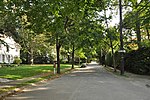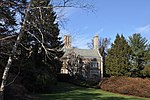Paine Estate
Houses completed in 1893Houses in Brookline, MassachusettsHouses on the National Register of Historic Places in Norfolk County, MassachusettsNational Register of Historic Places in Brookline, MassachusettsNorfolk County, Massachusetts Registered Historic Place stubs

The Paine Estate is a historic estate at 325 Heath Street in Brookline, Massachusetts. The mansion on the expansive estate was built by Walter Channing Cabot for his daughter Ruth and son-in-law Robert Treat Paine, Jr. It is a Jacobethan style Medieval Revival structure built of brick, with Flemish end gables, limestone sills and lintels, and egg-and-dart panels. It is one of the last estates, of what was once a whole series, which lined Heath Streat. The only other to remain (albeit no longer in private hands) is Roughwood, now the campus of Pine Manor College. The property was listed on the National Register of Historic Places in 1985.
Excerpt from the Wikipedia article Paine Estate (License: CC BY-SA 3.0, Authors, Images).Paine Estate
Heath Street,
Geographical coordinates (GPS) Address Nearby Places Show on map
Geographical coordinates (GPS)
| Latitude | Longitude |
|---|---|
| N 42.3225 ° | E -71.154166666667 ° |
Address
Heath Street 308
02447
Massachusetts, United States
Open on Google Maps







